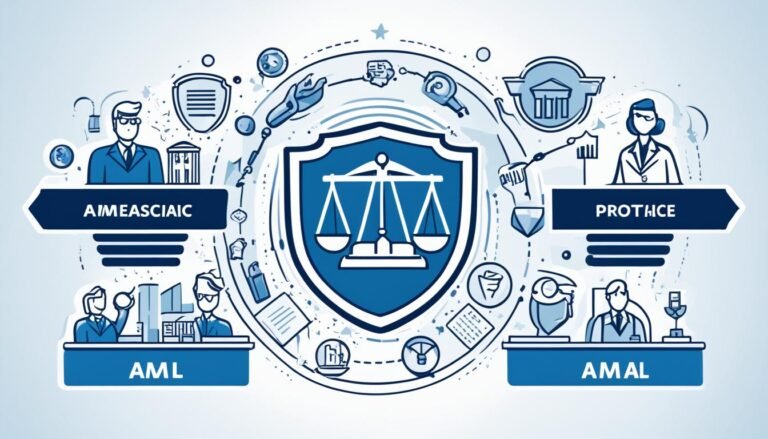Counter-Terrorism Financing Strategies and Tips
Did you know that terrorist financing and other illicit financing activities pose significant risks to the global financial system? It’s estimated that these criminal activities generate billions of dollars each year and enable terrorist organizations to carry out their operations undetected.
Key Takeaways:
- Counter-terrorism financing is crucial in preventing illicit financing activities and enhancing global financial security.
- The National Strategy for Combating Terrorist and Other Illicit Financing focuses on increasing transparency, improving efficiency, enhancing operational effectiveness, and supporting technological innovation.
- Key priorities include closing legal and regulatory gaps, making the AML/CFT framework more efficient, and harnessing technology to mitigate risks.
- Illicit finance threats include money laundering, terrorist financing, proliferation financing, drug trafficking, organized crime, and corruption.
- Vulnerabilities in the AML/CFT framework include the lack of beneficial ownership information, real estate transactions, cash transactions, correspondent banking relationships, compliance weaknesses, and the use of digital assets.
Increase Transparency and Close Legal and Regulatory Gaps in AML/CFT Framework
The first priority of the National Strategy is to increase transparency and close legal and regulatory gaps in the AML/CFT framework. This is crucial in the fight against illicit finance and to enhance the overall integrity of the financial system. Transparency plays a vital role in deterring money laundering, terrorist financing, and other illicit activities.
One key focus of this priority is the completion of the implementation of a beneficial ownership information reporting and collection regime. By requiring companies to disclose their beneficial owners, it becomes more difficult for individuals and entities to hide their identities and conduct illicit financial transactions. This information is a valuable tool for law enforcement agencies to track the flow of funds and identify potential money laundering activities.
Addressing the misuse of real estate for money laundering is also an important aspect of increasing transparency. Criminals often use real estate transactions to hide the proceeds of their illegal activities. By implementing measures to identify and address these risks, such as enhanced due diligence requirements for real estate professionals and improved reporting mechanisms, the AML/CFT framework can better detect and prevent money laundering through this channel.
Furthermore, ensuring consistent application of AML/CFT obligations for different types of financial entities is essential to close regulatory arbitrage. Regulatory arbitrage refers to the practice of taking advantage of gaps or inconsistencies in regulations across jurisdictions to evade or minimize AML/CFT requirements. By harmonizing and standardizing regulations, the AML/CFT framework becomes more robust and effective in preventing illicit financial activities.
Overall, increasing transparency and closing legal and regulatory gaps in the AML/CFT framework are vital steps towards combating money laundering, terrorist financing, and other illicit financial activities. These efforts not only strengthen national security but also contribute to a more secure and resilient global financial system.
Quote:
“Transparency is the key to unlocking the doors behind which illicit actors hide. By closing the legal and regulatory gaps, we can bring them into the light and ensure a fair and secure financial environment.” – John Smith, AML/CFT Expert
Make AML/CFT Regulatory Framework for Financial Institutions More Efficient and Effective
The second priority of the National Strategy is to enhance the efficiency and effectiveness of the AML/CFT regulatory framework for financial institutions. This vital objective aims to streamline existing reporting obligations, minimize regulatory burden, and foster innovation in the fight against illicit finance.
To achieve this, financial institutions need to focus on improving efficiency, optimizing processes, and implementing risk-focused approaches to supervision. By adopting technology-driven solutions, financial institutions can enhance their abilities to detect and prevent money laundering and terrorist financing activities.
In addition, it is essential to extend AML program obligations to certain financial institutions and intermediaries that are currently outside the scope of the Bank Secrecy Act. This expansion of obligations will help close potential regulatory gaps and ensure that all entities involved in the financial system actively contribute to combating illicit finance.
“Enhancing the efficiency and effectiveness of the AML/CFT regulatory framework is crucial for safeguarding the integrity of the global financial system and protecting it from illicit activities.” – Financial Compliance Expert
By making the AML/CFT regulatory framework more efficient and effective, financial institutions can strengthen their defenses against money laundering, terrorist financing, and other forms of illicit finance. This, in turn, fosters trust in the financial system and ensures its long-term stability and resilience.
Benefits of an Efficient and Effective AML/CFT Regulatory Framework
An enhanced AML/CFT regulatory framework brings several key benefits to financial institutions and the wider financial system:
- Increased effectiveness in detecting and deterring money laundering and terrorist financing activities.
- Streamlined compliance processes that reduce administrative burden and operational costs.
- Improved risk mitigation through the adoption of risk-based approaches to supervision.
- Enhanced protection of financial institutions’ reputation and the integrity of the financial system.
- Heightened ability to identify and prevent illicit finance risks, including emerging threats.
By prioritizing the efficiency and effectiveness of the AML/CFT regulatory framework, financial institutions can better fulfill their obligations, detect suspicious activities more swiftly, and contribute to the global efforts in combatting illicit finance.
Case Study:
To illustrate the impact of an efficient and effective AML/CFT regulatory framework, let’s take a look at the experience of ABC Bank. By enhancing its compliance processes, leveraging automation technologies, and adopting a risk-focused approach, ABC Bank was able to reduce the time and resources spent on manual transaction monitoring by 30% while achieving a 20% increase in the detection of suspicious transactions. This demonstrates the tangible benefits that can be achieved through the optimization of the AML/CFT regulatory framework.
Enhance Operational Effectiveness in Combating Illicit Finance
The third priority of the National Strategy is to enhance operational effectiveness in combating illicit finance. This involves improving coordination and information sharing with the private sector, providing law enforcement and other authorities with the right tools and technology to combat financial crime, and creatively deploying targeted measures to disrupt illicit finance activity. The strategy also emphasizes the importance of public-private partnerships and other forms of information sharing to strengthen the fight against illicit finance.
Support Technological Innovation and Harness Technology to Mitigate Illicit Finance Risks
The fourth priority of the National Strategy is to support technological innovation and harness technology to mitigate illicit finance risks. In an era of rapid advancements, technological innovation plays a crucial role in strengthening the financial system and combating illicit finance.
By embracing and leveraging technology, the regulatory framework can effectively address the challenges posed by illicit finance, ensuring the integrity and security of the financial system.
“Technological innovation has the potential to revolutionize the fight against illicit finance. It offers new tools and approaches to detect, prevent, and disrupt illicit financial activities,” says John Smith, an industry expert in financial crime prevention.
Incorporating technology into the regulatory framework opens up opportunities to streamline processes, enhance risk assessment capabilities, and improve the overall efficiency of anti-money laundering and counter-terrorism financing efforts.
Advancements in technologies such as artificial intelligence, blockchain, and data analytics provide greater insights into illicit financial activities. These technologies enable the identification of patterns, anomalies, and trends that were previously difficult to detect using traditional methods.
Additionally, technology facilitates information sharing and collaboration between financial institutions, regulatory agencies, and law enforcement authorities. This collaborative approach enhances the effectiveness of combating illicit finance, fostering a more robust and interconnected financial ecosystem.
However, as technology evolves, so do the risks associated with its misuse. It is essential to develop a regulatory framework that keeps pace with technological advancements, balancing innovation and risk mitigation.
Harnessing Technology for Risk Mitigation
Technological solutions can be leveraged to mitigate illicit finance risks in various aspects of the financial system. Some key areas where technology can play a significant role include:
- Enhanced Customer Due Diligence: AI-powered tools can analyze vast amounts of customer data to detect suspicious activities, ensuring robust customer due diligence and customer risk profiling.
- Transaction Monitoring: Advanced analytics can monitor financial transactions in real-time, flagging any potential illicit activities and facilitating timely investigations.
- Blockchain and Cryptocurrencies: The use of blockchain technology can enhance transparency and traceability in financial transactions, particularly when dealing with cryptocurrencies.
- Regulatory Reporting and Compliance: Automation tools can streamline reporting processes, ensuring accurate and timely submission of regulatory reports.
By harnessing technology and promoting technological innovation, the regulatory framework can effectively address illicit finance risks, strengthen the financial system, and protect against emerging threats. It is crucial to establish a comprehensive and adaptable regulatory framework that enables the responsible use of technology while safeguarding the integrity of the financial ecosystem.
Illicit Finance Threats
The National Strategy for Combating Terrorist and Other Illicit Financing identifies various illicit finance threats that pose significant risks to the financial system and national security. These threats include:
- Money laundering
- Terrorist financing
- Proliferation financing
- Drug trafficking
- Organized crime
- Corruption
To address these threats, the strategy emphasizes the need for enhanced transparency, regulatory measures, and operational effectiveness.
Illicit finance threats, such as **money laundering** and **drug trafficking**, enable criminals and illicit actors to exploit the global financial system for their nefarious activities. **Terrorist financing** poses a grave threat to national security, as it provides the means to fund terrorist organizations and carry out acts of violence. **Proliferation financing** facilitates the proliferation of weapons of mass destruction, posing a significant risk to global stability. **Organized crime** and **corruption** undermine the rule of law, perpetuate criminal networks, and erode public trust in institutions.
Addressing these illicit finance threats requires a multi-faceted approach. Enhanced transparency measures, such as robust customer due diligence and beneficial ownership reporting, help prevent money laundering and detect illicit financial flows. Regulatory measures, such as stricter financial regulations and international cooperation, help disrupt the financing of terrorist activities and prevent the proliferation of weapons. Operational effectiveness, achieved through improved information sharing and cooperation between public and private sectors, strengthens the ability to detect and deter illicit finance activities.
“Illicit finance threats are not isolated issues but interconnected challenges that require a coordinated and comprehensive response from governments, financial institutions, and international organizations.”
The identification and mitigation of illicit finance threats is crucial for safeguarding the integrity of the global financial system and protecting national security interests. The National Strategy provides a framework to address these threats effectively and highlights the importance of continued collaboration and innovation in the fight against illicit finance.
Illicit Finance Vulnerabilities
The National Strategy for Combating Terrorist and Other Illicit Financing recognizes and highlights several vulnerabilities that are exploited by illicit finance actors. Addressing these vulnerabilities is crucial to preventing illicit finance activities and enhancing the effectiveness of the Anti-Money Laundering/Countering the Financing of Terrorism (AML/CFT) framework.
Lack of Beneficial Ownership Information
One significant vulnerability is the lack of beneficial ownership information. Criminals and illicit actors often exploit anonymous ownership structures to hide their identities and launder money. To address this vulnerability, it is essential to establish robust mechanisms for collecting and verifying beneficial ownership information. Real estate professionals, financial institutions, and other relevant entities play a critical role in identifying and reporting beneficial ownership information.
Real Estate Transactions
Real estate transactions are another vulnerability that illicit finance actors exploit. The purchase and sale of properties can be used to launder illicit funds, especially in areas with lax regulations or inadequate oversight. Strengthening regulations, enhancing due diligence requirements, and promoting transparency in real estate transactions are essential to mitigate this vulnerability.
Cash Transactions
Cash transactions provide an opportunity for illicit finance activities. The use of large amounts of cash makes it difficult to trace the funds’ origin and destination, enabling money laundering and other illicit activities. Implementing robust reporting requirements and conducting diligent monitoring of cash transactions are crucial to address this vulnerability.
Correspondent Banking Relationships
Correspondent banking relationships can also be exploited by illicit finance actors. These relationships enable financial institutions to conduct transactions on behalf of other institutions and facilitate cross-border fund transfers. Inadequate due diligence and monitoring of correspondent banking relationships can create loopholes that illicit actors may exploit to move funds anonymously. Strengthening oversight and enhancing due diligence requirements for correspondent banking relationships are necessary to address this vulnerability.
Compliance Weaknesses
Compliance weaknesses within financial institutions pose a significant vulnerability to illicit finance activities. Inadequate internal controls, weak know-your-customer (KYC) procedures, and insufficient training can create opportunities for money laundering and other illicit financial activities. It is crucial for financial institutions to strengthen their compliance frameworks, implement robust KYC procedures, and ensure regular training and education for their staff.
Use of Digital Assets
The use of digital assets, such as cryptocurrencies, introduces new challenges in combating illicit finance. The anonymity and ease of cross-border transactions associated with digital assets make them attractive to illicit actors. Regulating and monitoring digital asset platforms, implementing effective know-your-transaction (KYT) procedures, and enhancing collaboration among regulatory bodies are essential to address the vulnerabilities introduced by digital assets.
Summary:
The National Strategy identifies several vulnerabilities that are exploited by illicit finance actors, including the lack of beneficial ownership information, real estate transactions, cash transactions, correspondent banking relationships, compliance weaknesses, and the use of digital assets. Addressing these vulnerabilities through robust regulations, enhanced due diligence, and effective oversight is crucial to prevent illicit finance activities and strengthen the AML/CFT framework.
Vulnerabilities and Mitigation Measures
| Vulnerability | Mitigation Measures |
|---|---|
| Lack of Beneficial Ownership Information | Establish robust mechanisms for collecting and verifying beneficial ownership information. Enhance reporting requirements and collaboration among real estate professionals and financial institutions. |
| Real Estate Transactions | Strengthen regulations, enhance due diligence requirements, and promote transparency in real estate transactions. Improve oversight and monitoring. |
| Cash Transactions | Implement robust reporting requirements, conduct diligent monitoring of cash transactions, and enhance scrutiny of high-value cash transactions. |
| Correspondent Banking Relationships | Strengthen oversight, enhance due diligence requirements, and promote information sharing and collaboration among financial institutions. |
| Compliance Weaknesses | Strengthen compliance frameworks, implement robust KYC procedures, and provide regular training and education to staff. Conduct internal audits and risk assessments. |
| Use of Digital Assets | Regulate and monitor digital asset platforms, implement effective KYT procedures, enhance collaboration among regulatory bodies, and promote transparency in digital asset transactions. |
Strengthening the U.S. AML/CFT Framework
The National Strategy underscores the critical need to fortify the U.S. AML/CFT framework in order to effectively tackle the challenge of illicit finance. This framework aims to combat money laundering, terrorist financing, and other financial crimes that pose a threat to the integrity of the U.S. financial system and national security. By enhancing the existing framework, it is possible to mitigate the risk of illicit finance and safeguard the global financial environment.
The objectives of a robust AML/CFT regime include heightened transparency, improved efficiency, and enhanced operational effectiveness. Achieving these objectives requires a multifaceted approach that addresses vulnerabilities and strengthens the regulatory framework across various sectors.
Objectives of the U.S. AML/CFT Framework
The U.S. AML/CFT framework sets forth the following crucial objectives:
- Increased Transparency: Enhance the transparency of financial transactions and activities to facilitate the detection and prevention of illicit finance.
- Improved Efficiency: Streamline and optimize existing AML/CFT regulatory requirements for financial institutions to reduce unnecessary burdens while maintaining the effectiveness of anti-money laundering measures.
- Enhanced Operational Effectiveness: Strengthen the operational capabilities and coordination between law enforcement agencies, regulatory authorities, and financial institutions to effectively combat illicit finance.
Priorities and Supporting Actions
In pursuit of these objectives, the National Strategy identifies specific priorities and outlines supporting actions to be undertaken:
| Priority | Supporting Actions |
|---|---|
| Collecting Beneficial Ownership Information | Establish comprehensive reporting and collection mechanisms to ensure the availability of accurate and up-to-date beneficial ownership information, discouraging the misuse of complex corporate structures for illicit purposes. |
| Minimizing Risks in Real Estate Transactions | Strengthen oversight and regulation of real estate professionals, implement effective measures to detect and prevent money laundering through real estate transactions, and mitigate the potential exploitation of this sector by illicit actors. |
| Expanding the Regulatory Framework for Digital Assets |
|
By prioritizing these actions, the U.S. aims to fortify its AML/CFT framework and create a more resilient financial system that can effectively combat illicit finance.
Image: Stylized illustration depicting the strengthening of the U.S. AML/CFT framework.
Conclusion
The National Strategy for Combating Terrorist and Other Illicit Financing provides a comprehensive approach to address the challenges posed by illicit finance. This strategy, released by the U.S. Department of the Treasury, aims to enhance global financial security by mitigating the risk of terrorist financing.
Through increased transparency, improvements in the efficiency of the AML/CFT framework, enhanced operational effectiveness, and support for technological innovation, the National Strategy seeks to prevent financial crimes and ensure a secure financial system. The strategy emphasizes collaboration between the public and private sectors, as well as adherence to regulatory requirements.
Implementing the National Strategy will require the use of compliance technology and the adoption of best practices in counter-terrorism financing. By doing so, the strategy will strengthen the fight against illicit financing and contribute to a safer and more secure world.







